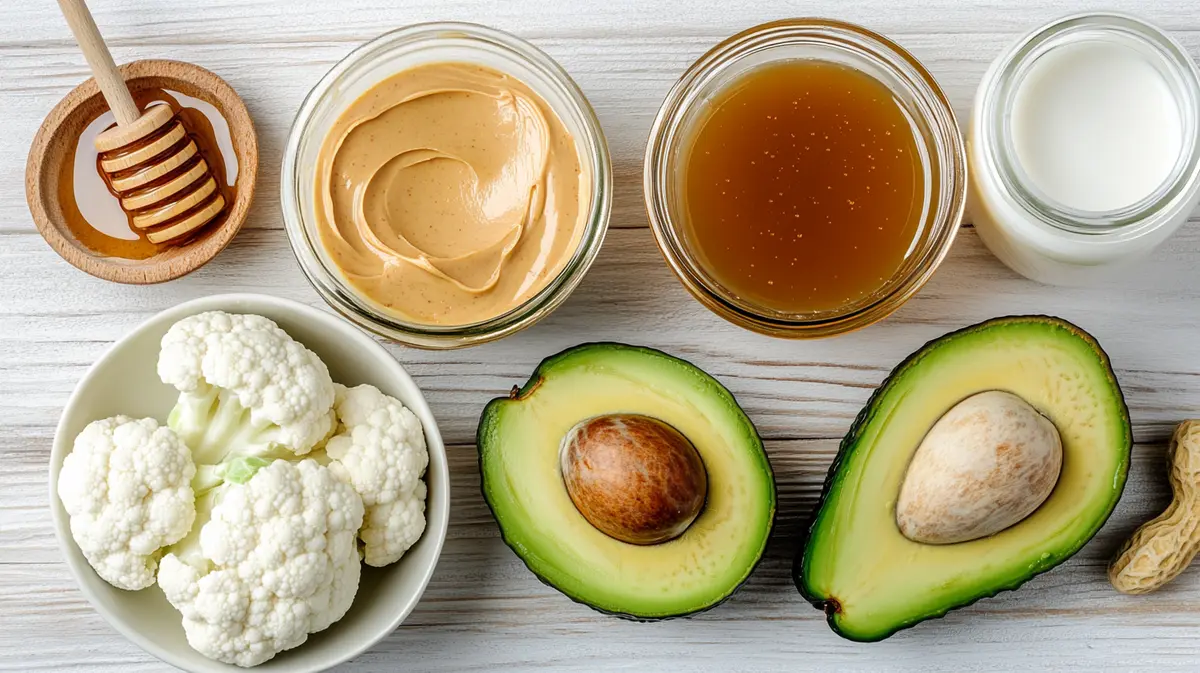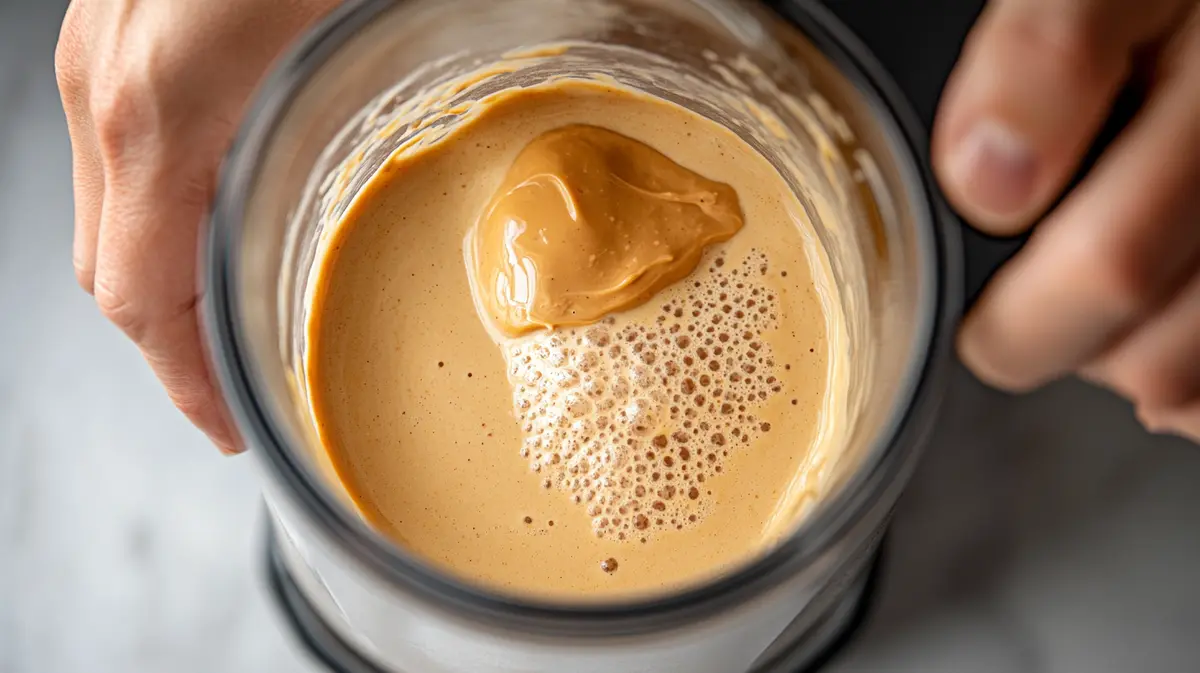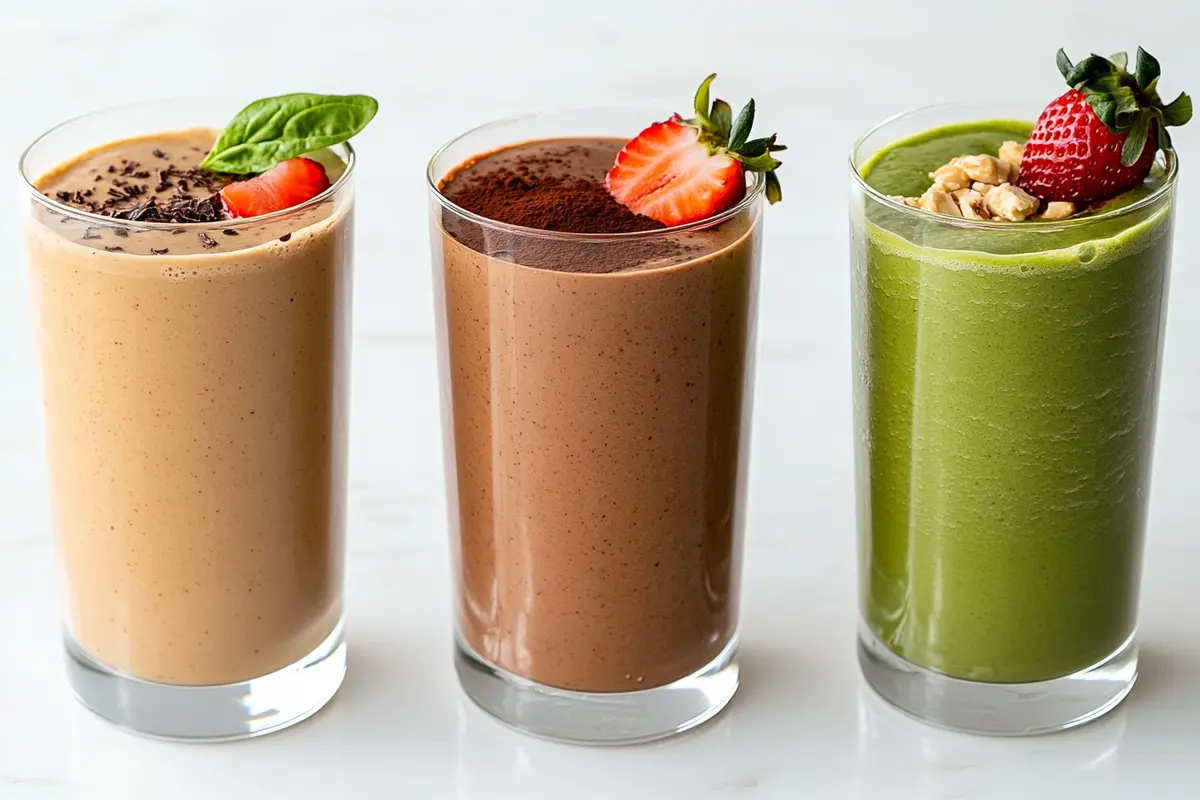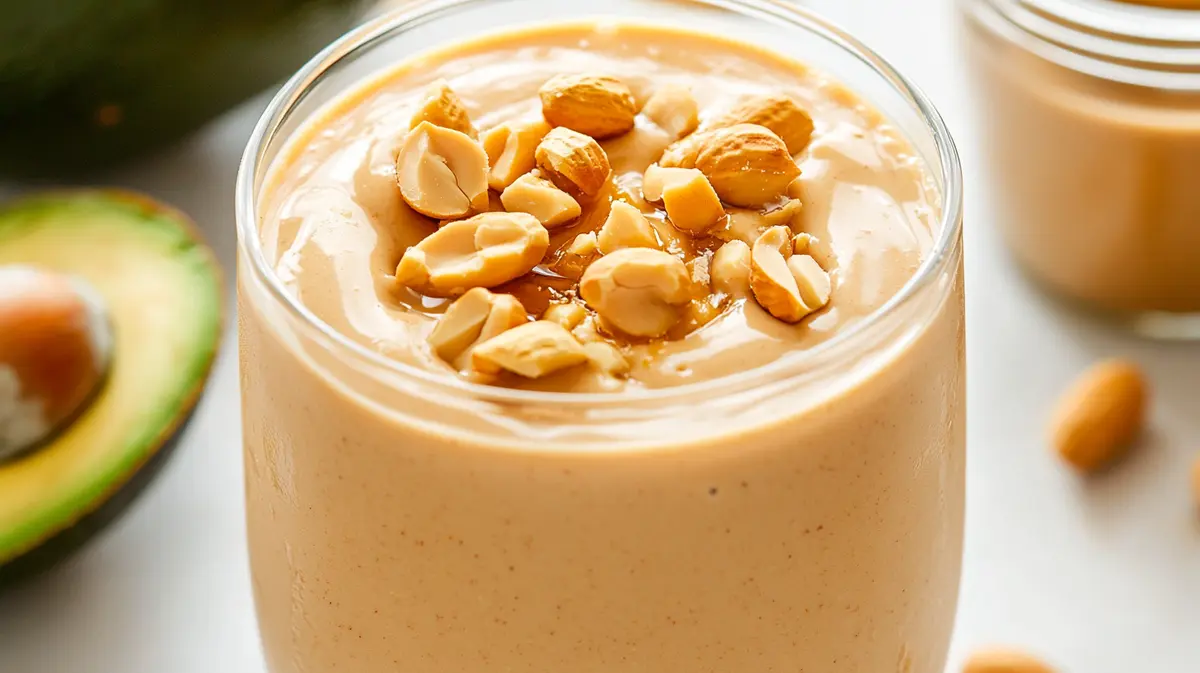Introduction:
Do you love Peanut Butter Smoothie Without Banana but can’t stand bananas? You’re not alone! Many recipes use bananas for creaminess. But, we’ve found ways to make rich, creamy drinks without bananas.
Now, you can mix peanut butter with avocado or frozen cauliflower. This article will show you how to get the right texture and taste. Say goodbye to compromises and enjoy smoothies that fit your diet or taste!
Key Takeaways
- Explore peanut butter smoothie no banana options with creative substitutes.
- Learn how to achieve smooth textures using milk, avocado, or frozen fruit.
- Find banana-free recipes that suit allergies, dietary needs, or taste preferences.
- Discover natural sweeteners and mix-ins to enhance flavor without bananas.
- Get pro tips to avoid common blending mistakes and ensure perfect consistency.
Why Make a Peanut Butter Smoothie Without Banana?
Many people avoid bananas in smoothies for good reasons. This could be due to allergies, dietary needs, or just not liking the taste. Swapping bananas for other ingredients can lead to creamy and tasty smoothies.
Common Banana Allergies and Sensitivities
Allergies to bananas can cause mouth itching or swelling. This is linked to oral allergy syndrome. For those with allergies, finding banana allergy smoothie alternatives is crucial. Cross-reactions with other foods or pollens also make banana-free recipes necessary.
Dietary Restrictions That Limit Banana Consumption
Bananas have 14-19g of carbs per serving. This makes them unsuitable for keto peanut butter smoothies or strict low-carb smoothie options. People following paleo, vegan, or diabetic diets often look for substitutes to keep their diet on track without losing flavor.
Flavor Preferences Beyond Traditional Recipes
- Not everyone likes the sweet taste of bananas.
- Ingredients like avocado or mango add new flavors.
- Creaminess can come from spinach, coconut milk, or even frozen cauliflower.
Not using bananas doesn’t mean you have to give up on good taste or nutrition. Try different textures and flavors to find your favorite!
The Perfect Base for Your Banana-Free Peanut Butter Smoothie
Choosing the right smoothie base alternatives keeps your peanut butter smoothie rich and balanced. Start with a creamy smoothie foundation that matches the nutty flavor without bananas. Here’s how to pick your peanut butter smoothie liquid base:
- Milk alternatives: Almond milk (unsweetened) or oat milk (like Oatly) add subtle sweetness and creaminess.
- Coconut water: Offers natural electrolytes and a slight tropical hint without overpowering peanut butter.
- Fruit juices: Apple or pear juice sweeten naturally while thinning the texture for a peanut butter smoothie liquid base.
A creamy smoothie foundation depends on the liquid-to-solid ratio. For a thick shake, use ½ cup liquid to 1 cup solids. For a drinkable version, increase liquid to ¾ cup. Test ratios in small batches first!
| Base Type | Texture Goal | Ratio Example |
|---|---|---|
| Almond milk | Thick & spoonable | ½ cup liquid + 1 cup peanut butter + ice |
| Coconut water | Light & refreshing | ¾ cup liquid + ¾ cup solids |
| Oat milk | Ultra-creamy | ⅔ cup liquid + 1 cup frozen mango |
Experiment with these smoothie base alternatives to find your favorite. Adjust slowly—small tweaks make big differences! Your next smoothie could be the best one yet.
Essential Ingredients for a Creamy Peanut Butter Smoothie Without Banana

Creating a creamy peanut butter smoothie without banana starts with the right ingredients. Each part adds to the smoothie’s texture and taste. Here’s how to choose the best ones.
Choosing the Right Peanut Butter
Quality peanut butter is key. Look for natural peanut butter smoothies with just peanuts and salt. Avoid those with added sugars or oils. Some top picks are:
- Justin’s All-Natural Creamy
- Smuckers’s Natural
- 365 Everyday Value Organic
Use 1–2 tablespoons per serving. This balances richness without overpowering other flavors.
Best Milk Options for Smoothie Texture
Nut milk smoothie recipes need the right base. Oat milk (Oatly Original) adds creaminess. Almond milk (Pacific Foods) makes it light. Coconut milk (Native Forest) brings a hint of tropical flavor. For a classic taste, try 2% milk.
Natural Sweeteners That Complement Peanut Butter
Sweetness should enhance, not overpower. Try:
- Honey or honey maple syrup smoothie blends (1–2 teaspoons)
- Pitted dates (soaked first for easier blending)
- Stevia for a sugar-free option
Maple syrup works well with nutty flavors. Start with a small amount to avoid over-sweetening.
Top Fruit Alternatives to Replace Bananas in Your Smoothie
Try these alternatives to bananas for creamy and tasty smoothies. Each one brings unique flavors without banana’s starchiness.
Avocado: The Creamy Green Substitute
Add ¼ to ½ an avocado for a rich texture. Its mild taste pairs well with peanut butter. Try it in an avocado peanut butter smoothie with almond milk and vanilla. Avocado’s healthy fats make you feel full without overpowering other tastes.
Mango and Pineapple Options
Mango and pineapple add natural sweetness. Use ½ cup each of fresh or frozen chunks for a tropical fruit smoothie recipes twist. Pineapple’s tanginess balances peanut butter’s richness, while mango thickens the smoothie. Add coconut water for extra hydration.
Using Frozen Cauliflower for Undetectable Creaminess
Blend ½ cup frozen cauliflower florets into your smoothie for hidden vegetable smoothies. Its mild taste blends with peanut butter and berries. This adds fiber and nutrients without changing the taste.
- Avocado Tip: Peel and pit before freezing for easy portioning.
- Cauliflower Hack: Thaw florets first if your blender struggles with ice.
- Storage: Prep ingredients in advance for quick morning mixes.
These swaps are great for different diets or tastes. Experiment with ratios to find your favorite mix of creaminess and flavor!
Health Benefits of Peanut Butter Smoothie Without Banana
Peanut butter is packed with 7–8g of protein per 2 tablespoons. This makes these smoothies great for those looking for protein. The natural fats in peanut butter are also good for your heart, thanks to their monounsaturated fats. Without bananas, you can adjust these smoothies to fit your dietary needs.
- Add chia seeds for omega-3s and fiber.
- Spinach adds iron and vitamin K without overpowering flavor.
- Protein powder enhances amino acids for muscle recovery.
| Ingredient | Nutritional Role |
|---|---|
| Peanut Butter | Protein + healthy fats |
| Flaxseeds | Omega-3s and fiber boost |
| Coconut Milk | Medium-chain fats for energy |
These smoothies are both tasty and nutritious. The fats help you feel full longer, and the protein supports muscle health. You can add berries for antioxidants or matcha for a metabolism boost. They’re great for busy mornings or after working out, fitting any diet.
How to Achieve the Perfect Texture Without Using Bananas

Getting the right texture in thick creamy smoothies without bananas is all about choosing the right ingredients and techniques. Here are three main steps to help you avoid watery or jammed blenders.
- Greek yogurt smoothie recipes use ¼ cup non-fat Greek yogurt to add protein and body.
- Silken tofu (1–2 tablespoons) blends seamlessly for a creamy base.
- Pre-soaked chia seeds (1 tbsp in water 10 minutes before blending).
- Xanthan gum (½ tsp) for a quick thickening boost—use sparingly to avoid gummy textures.
Blending secrets: Follow this sequence for consistent results:
- Add liquids first (milk, water) to coat blades.
- Layer in powders (yogurt, protein powder) and soft ingredients (peanut butter).
- End with frozen items and use 30-second pulses instead of continuous blending.
Ice vs. frozen fruit: Choose based on your goal:
- Frozen fruit smoothie techniques lock in natural sweetness and thicker consistency.
- Ice cubes chill faster but can dilute flavor—use ¼ less than frozen fruit.
Still struggling? Try reducing liquid by ¼ cup or add a frozen banana (if tolerated). Experiment to find your perfect balance!
Five Delicious Peanut Butter Smoothie Without Banana Recipes

Try these easy recipes that skip bananas but still taste creamy and yummy. Each one has been tested to get the right mix of taste and texture.
- Chocolate Peanut Butter Smoothie (Avocado Base)Mix 2 tbsp natural peanut butter, ½ ripe avocado, 1 tbsp cocoa powder, 1 cup almond milk, and 1 date. Blend until smooth. Add ice for thickness. Top with crushed peanuts.
- Strawberry Peanut Butter ShakeBlend 3 tbsp creamy peanut butter, 1 cup frozen strawberries, ½ cup Greek yogurt, ½ cup oat milk, and 1 tsp honey. Serve with a strawberry garnish. For a dairy-free option, use coconut yogurt.
- Coffee Protein SmoothieCombine 2 tbsp peanut butter, 1 scoop vanilla protein powder, ½ cup cold brew coffee, 1 cup unsweetened almond milk, and 1 tbsp chia seeds. Whisk well for a morning energy boost.
- Tropical Mango Protein SmoothieUse 2 tbsp peanut butter, 1 cup frozen mango chunks, ½ cup coconut milk, 1 cup pineapple juice, and a dash of vanilla extract. Blend until creamy. Add ice if needed.
- Green Power SmoothieBlend 2 tbsp peanut butter, 1 cup spinach, ½ cup cauliflower rice (blended first), 1 cup unsweetened cashew milk, and 1 banana substitute like pear. Add a dash of cinnamon.
“Experiment with add-ins like flaxseeds or matcha powder to boost nutrition!”
Adjust sweetness or thickness to taste. Store leftovers in airtight containers for up to 24 hours. All recipes are nut-free if using sunflower seed butter. Enjoy your next smoothie adventure—no bananas required!
Common Mistakes to Avoid When Making Banana-Free Smoothies
Even the most experienced cooks can face challenges when making banana-free peanut butter smoothies. These smoothie troubleshooting tips can help you avoid common problems before they occur.
Ingredient Ratios That Can Ruin Your Smoothie
- Peanut butter overload: Use 1–2 tbsp per serving to avoid clogged blenders or overpowering taste.
- Liquid imbalance: Start with ½ cup liquid (almond milk, coconut water) and adjust for perfect smoothie consistency.
Tip: Add thickening agents like chia seeds gradually—¼ tsp at a time.
Temperature Tips for the Best Results
Cold peanut butter clumps easily. Always use room-temperature peanut butter for smoother blends. Pair with at least one frozen ingredient (ice, berries) to maintain chill without icy chunks.
“Balanced smoothie flavors start with mindful mixing,” says Chef Maria Lopez of Plant-Powered Kitchen. “Test small tweaks before scaling recipes.”
| Mistake | Fix |
|---|---|
| Over-sweetening | Add a dash of vanilla extract or a squeeze of lemon |
| Weak flavor | Increase peanut butter by ½ tbsp or add cocoa powder |
Adjust flavors layer by layer. Start with base, then add sweeteners or spices incrementally. Taste as you go!
Here’s your updated conclusion with the internal link naturally integrated:
Conclusion: Enjoying Your Banana-Free Peanut Butter Smoothie Journey
Banana-free peanut butter smoothies show that you can be creative in the kitchen. They’re great if you’re avoiding allergens or just want to try new tastes. Avocado, mango, and cauliflower are top picks for making smoothies that are both healthy and tasty.
These smoothie alternatives let you make peanut butter breakfasts that are just right for you. Try adding thickeners or frozen fruits to get the perfect mix. You can even experiment with different nut butters—like pecan butter, which offers a rich, buttery flavor and extra nutrients. Learn more about its benefits and recipes here.
Remember, the best smoothies are the ones you like the most. Start with our tips, then adjust the ingredients to fit your taste. There’s no wrong way to make a smoothie—just enjoy the process. Happy blending, and cheers to every delicious smoothie you make!
FAQ
Can I make a peanut butter smoothie without bananas?
Absolutely! You can use many tasty alternatives to bananas. Avocado, mango, or even frozen cauliflower can add creaminess and sweetness.
What are the best substitutes for banana in peanut butter smoothies?
Avocado makes it creamy, mango adds sweetness, and frozen cauliflower boosts nutrition. Each adds a unique flavor and texture.
How can I achieve the right texture in a banana-free smoothie?
Use Greek yogurt or chia seeds for thickness. Blend liquids first and add ice or frozen fruits for the right consistency.
Are there health benefits to banana-free peanut butter smoothies?
Yes! Peanut butter has protein and healthy fats for muscle recovery and energy. Adding spinach or chia seeds makes it even healthier.
What should I avoid when making a peanut butter smoothie without bananas?
Avoid too much peanut butter or liquid for texture. Use room-temperature peanut butter for smoother blending.
How do I sweeten my banana-free smoothie?
Use honey, maple syrup, or medjool dates for natural sweetness. They balance the savory peanut butter flavor.
Can I use protein powder in my banana-free smoothie?
Definitely! Protein powder increases protein, perfect for post-workout or as a meal. Adjust other ingredients for taste and texture.
How can I make my smoothie more filling?
Add healthy fats like avocado or nut butters. Include fiber-rich ingredients like oats or seeds. These keep you full longer.

